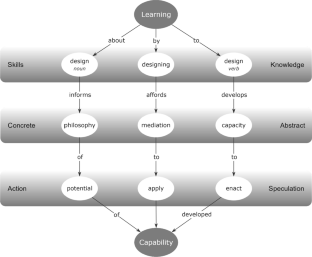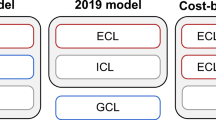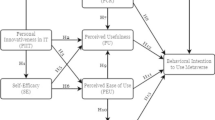Abstract
Design as a construct has multiple meanings depending on context, function, and agenda. This paper proposes to set out functions of design as it manifests in the context of technological activity for the purposes of technology education. The importance of context and by association intention in technological and designerly activity is presented with reference to recent reforms of lower secondary school subjects in Ireland, in an attempt to demonstrate the complexity of design’s treatment in technological activity. Critical to the success of designerly outcomes and outputs, is having a clear intention for the objectives of learning. This paper proposes a framework of articulations of design in the context of technological activity that attempts to position its utility with respect to the development of capability. Unpacking ‘learning about design’, ‘learning by design’ and ‘learning to design’ provides delineated intent that makes explicit learning, pedagogical, and evaluative decisions, reinforcing the position that it is what learners can do opposed to know, that is central to technological activity.

Similar content being viewed by others
References
Argyris, C., & Schön, D. A. (1974). Theory in practice: Increasing professional effectiveness (1st ed.). Jossey-Bass Publishers.
Atkinson, S. (2017). So what went wrong and why? In Design epistomology and curriculum planning (pp. 13–17). Loughborough Design Press.
Baynes, K. (2013). DESIGN: Models of change. Loughborough: Loughborough Design Press.
Bisadi, M., Mozaffar, F., & Hosseini, S. B. (2012). Future research centers: The place of creativity and innovation. Procedia Social and Behavioral Sciences, 68, 232–243. https://doi.org/10.1016/j.sbspro.2012.12.223
Bourdieu, P. (1984). Distinction: A social critique of the judgement of taste (11. print). Harvard Univ. Press.
Buckley, J., Seery, N., Gumaelius, L., Canty, D., Doyle, A., & Pears, A. (2020). Framing the constructive alignment of design within technology subjects in general education. International Journal of Technology and Design Education.
Buckley, J. (In Press). Historical and philosophical origins of technology education. In In The bloomsbury handbook of technology education: Perspectives and practice. Bloomsbury.
Buckley, J., Seery, N., Gumaelius, L., Canty, D., Doyle, A., & Pears, A. (2021). Framing the constructive alignment of design within technology subjects in general education. International Journal of Technology and Design Education, 31(5), 867–883. https://doi.org/10.1007/s10798-020-09585-y
Dunbar, R., Buckley, J., & Seery, N. (2019). Curriculum development for technology teacher education: Integrating pedagogy, epistemology and capability. In S. Pule (Ed.), PATT2019: Developing a knowledge economy through technology and engineering education. Msida, Malta: University of Malta.
Einstein, A. (1931). Cosmic religion: With other opinions and aphorisms.
Expert Group on Future Skills Needs. (2017). Winning by design: An introduction to the design skills required for firms to be innovative and competitive in global markets. National Skills Council.
Goel, V. (1995). Sketches of thought. MIT Press.
Haupt, G. (2015). Learning from experts: Fostering extended thinking in the early phases of the design process. International Journal of Technology and Design Education, 25(4), 483–520. https://doi.org/10.1007/s10798-014-9295-7
Héder, M., & Paksi, D. (2018). Non-human knowledge according to Michael Polanyi”. Tradition and Discovery: the Polanyi Society Periodical, 44(1), 50–66.
Keirl, S. (2017). Some thoughts on locating design knowledge. In Design epistomology and curriculum planning (pp. 22–27). Loughborough Design Press.
Kelly, A. V., Kimbell, R., Patterson, V., Saxton, J., & Stables, K. (1987). Design and technological activity: A framework for assessment.
Kimbell, R., & Stables, K. (2007). Researching design learning: Issues and findings from two decades of research and development. Springer.
Kimbell, R. (2011). Wrong… but right enough. Design and Technology Education: an International Journal, 16(2), 6–7.
Kirsh, D. (2017). Thinking with external representations. In S. J. Cowley & F. Vallée-Tourangeau (Eds.), Cognition beyond the brain (pp. 61–84). Springer International Publishing. https://doi.org/10.1007/978-3-319-49115-8_4
Kirsh, D. (2013). Thinking with external representations. In S. J. Cowley & F. Vallée-Tourangeau (Eds.), Cognition beyond the brain (pp. 171–194). London: Springer.
Kolb, D. A. (1984). Experiential learning: Experience as the source of learning and development (Vol. 1). Englewood Cliffs, NJ: Prentice-Hall.
Lu, S.C.-Y., & Liu, A. (2012). Abductive reasoning for design synthesis. CIRP Annals, 61(1), 143–146. https://doi.org/10.1016/j.cirp.2012.03.062
McGarr, O., & Lynch, R. (2017). Monopolising the STEM agenda in second-level schools: Exploring power relations and subject subcultures. International Journal of Technology and Design Education, 27(1), 51–62. https://doi.org/10.1007/s10798-015-9333-0
Mitchan, C. (1994). Thinking through technology: The path between engineering and philosophy. University of Chicago Press.
NCCA. (2015a). Framework for junior cycle. Department of Education and Skills.
NCCA. (2015b). Junior cycle applied technology. An Roinn Oideachais agus Scileanna.
NCCA. (2015c). Junior cycle engineering. An Roinn Oideachais agus Scileanna.
NCCA. (2015d). Junior cycle graphics. An Roinn Oideachais agus Scileanna.
NCCA. (2015e). Junior cycle wood technology. An Roinn Oideachais agus Scileanna.
Nelson, H. G., & Stolterman, E. (2003). The design way. Educational Technology Publications.
Norman, E., & Seery, N. (2013). The creative relationships between designing and making. In Design education: A vision for the future (pp. 78–86). Loughborough Design Press.
Norman, E. (2017). First thoughts on design epistomology. In Design epistomology and curriculum planning. Loughborough Design Press.
Norman, E. (2013). Design epistemology and curriculum planning. Design and Technology Education: An International Journal, 18(2), 3–5.
Paas, F., & Sweller, J. (2012). An evolutionary upgrade of cognitive load theory: using the human motor system and collaboration to support the learning of complex cognitive tasks. Educational Psychology Review, 24(1), 27–45. https://doi.org/10.1007/s10648-011-9179-2
Restrepo, J., & Christiaans, H. (2004). Problem structuring and information access in design. Journal of Design Research. https://doi.org/10.1504/JDR.2004.009842
Roberts, P. (1992). Of models, modelling, and design: an applied philosophical enquiry. In P. Roberts, B. Archer, & K. Baynes (Eds.), Design: occasional paper No1: modelling: the language of designing (pp. 32–42). Loughborough University.
Ryle, G. (2009). The concept of mind. Routledge.
Schmidt, F. L., & Hunter, J. E. (1993). Tacit knowledge, practical intelligence, general mental ability, and job knowledge. Current Directions in Psychological Science, 2(1), 8–9. https://doi.org/10.1111/1467-8721.ep10770456
Schön, D. A. (1983). The reflective practitioner: How professionals think in action. Basic Books.
Seery, N. (2017). Modelling as a form of critique. In P. J. Williams & K. Stables (Eds.), Critique in design and technology education (pp. 255–273). Springer Singapore.
Spendlove, D. (2017). Spendlove, D. (2017). Design thinking: What is it and where might it reside? In E. Norman & K. Baynes (Eds.), Design epistemology and curriculum planning (pp. 39–42). Loughborough Design Press.
Stables, K. (2008). Designing matters; designing minds: The importance of nurturing the designerly in young people. Design and Technology Education: An International Journal, 13(3).
Sweller, J. (2011). Cognitive load theory. In Psychology of learning and motivation (Vol. 55, pp. 37–76). Elsevier. https://doi.org/10.1016/B978-0-12-387691-1.00002-8
Williams, P. J. (2011). Dispositions as explicit learning goals for engineering and technology education. In M. Barak & M. Hacker (Eds.), Fostering human development through engineering and technology education (p. 89). SensePublishers.
Yoshikawa, H. (1989). Design philosophy: The state of the art. CIRP Annals, 38(2), 579–586. https://doi.org/10.1016/S0007-8506(07)61126-3
Author information
Authors and Affiliations
Corresponding author
Additional information
Publisher's Note
Springer Nature remains neutral with regard to jurisdictional claims in published maps and institutional affiliations.
Rights and permissions
Springer Nature or its licensor holds exclusive rights to this article under a publishing agreement with the author(s) or other rightsholder(s); author self-archiving of the accepted manuscript version of this article is solely governed by the terms of such publishing agreement and applicable law.
About this article
Cite this article
Seery, N., Phelan, J., Buckley, J. et al. Epistemological treatment of design in technology education. Int J Technol Des Educ 33, 1547–1561 (2023). https://doi.org/10.1007/s10798-022-09781-y
Accepted:
Published:
Issue Date:
DOI: https://doi.org/10.1007/s10798-022-09781-y




